2017 NISSAN VERSA NOTE fog light
[x] Cancel search: fog lightPage 182 of 414
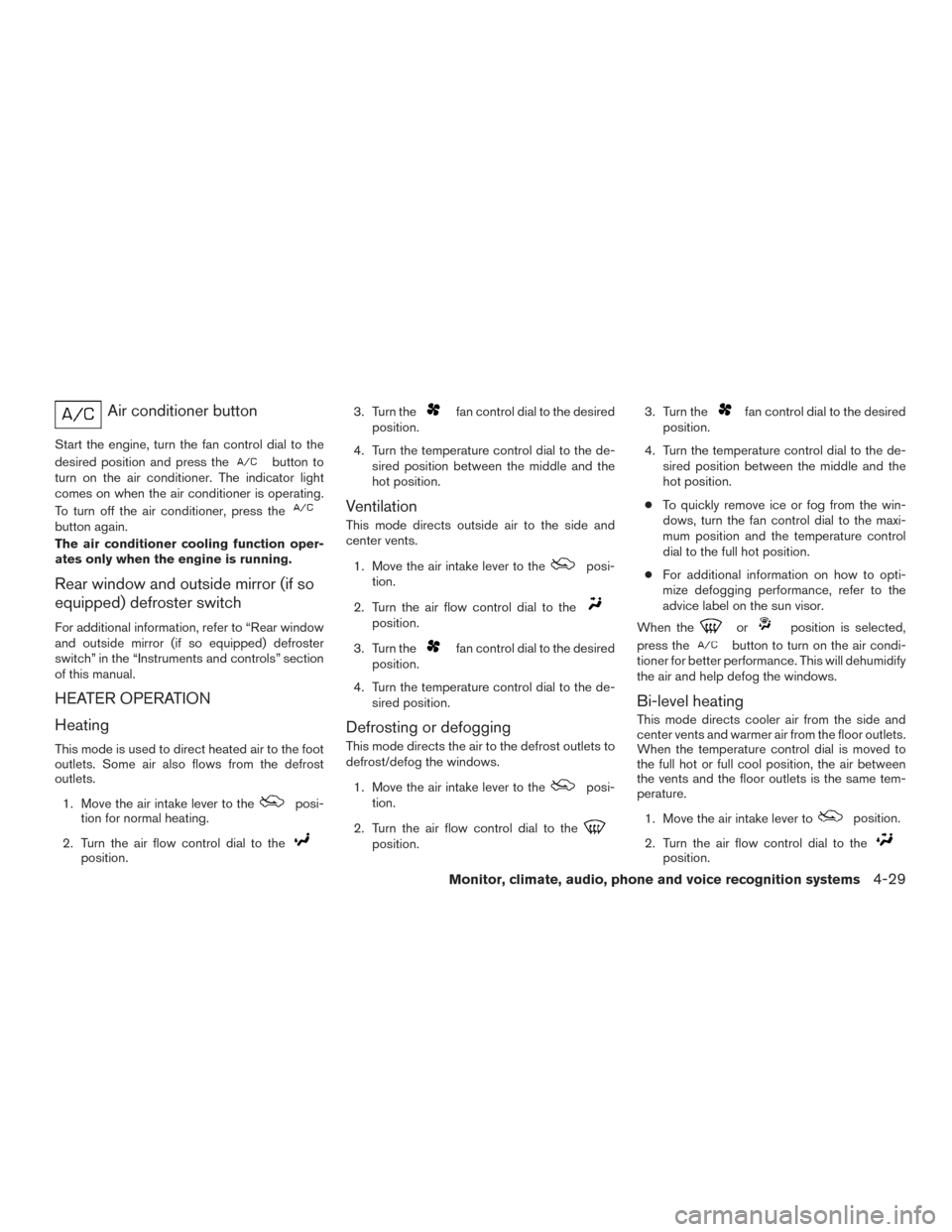
Air conditioner button
Start the engine, turn the fan control dial to the
desired position and press the
button to
turn on the air conditioner. The indicator light
comes on when the air conditioner is operating.
To turn off the air conditioner, press the
button again.
The air conditioner cooling function oper-
ates only when the engine is running.
Rear window and outside mirror (if so
equipped) defroster switch
For additional information, refer to “Rear window
and outside mirror (if so equipped) defroster
switch” in the “Instruments and controls” section
of this manual.
HEATER OPERATION
Heating
This mode is used to direct heated air to the foot
outlets. Some air also flows from the defrost
outlets.
1. Move the air intake lever to the
posi-
tion for normal heating.
2. Turn the air flow control dial to the
position. 3. Turn the
fan control dial to the desired
position.
4. Turn the temperature control dial to the de- sired position between the middle and the
hot position.
Ventilation
This mode directs outside air to the side and
center vents.
1. Move the air intake lever to the
posi-
tion.
2. Turn the air flow control dial to the
position.
3. Turn the
fan control dial to the desired
position.
4. Turn the temperature control dial to the de- sired position.
Defrosting or defogging
This mode directs the air to the defrost outlets to
defrost/defog the windows.
1. Move the air intake lever to the
posi-
tion.
2. Turn the air flow control dial to the
position. 3. Turn the
fan control dial to the desired
position.
4. Turn the temperature control dial to the de- sired position between the middle and the
hot position.
● To quickly remove ice or fog from the win-
dows, turn the fan control dial to the maxi-
mum position and the temperature control
dial to the full hot position.
● For additional information on how to opti-
mize defogging performance, refer to the
advice label on the sun visor.
When the
orposition is selected,
press the
button to turn on the air condi-
tioner for better performance. This will dehumidify
the air and help defog the windows.
Bi-level heating
This mode directs cooler air from the side and
center vents and warmer air from the floor outlets.
When the temperature control dial is moved to
the full hot or full cool position, the air between
the vents and the floor outlets is the same tem-
perature.
1. Move the air intake lever to
position.
2. Turn the air flow control dial to the
position.
Monitor, climate, audio, phone and voice recognition systems4-29
Page 183 of 414
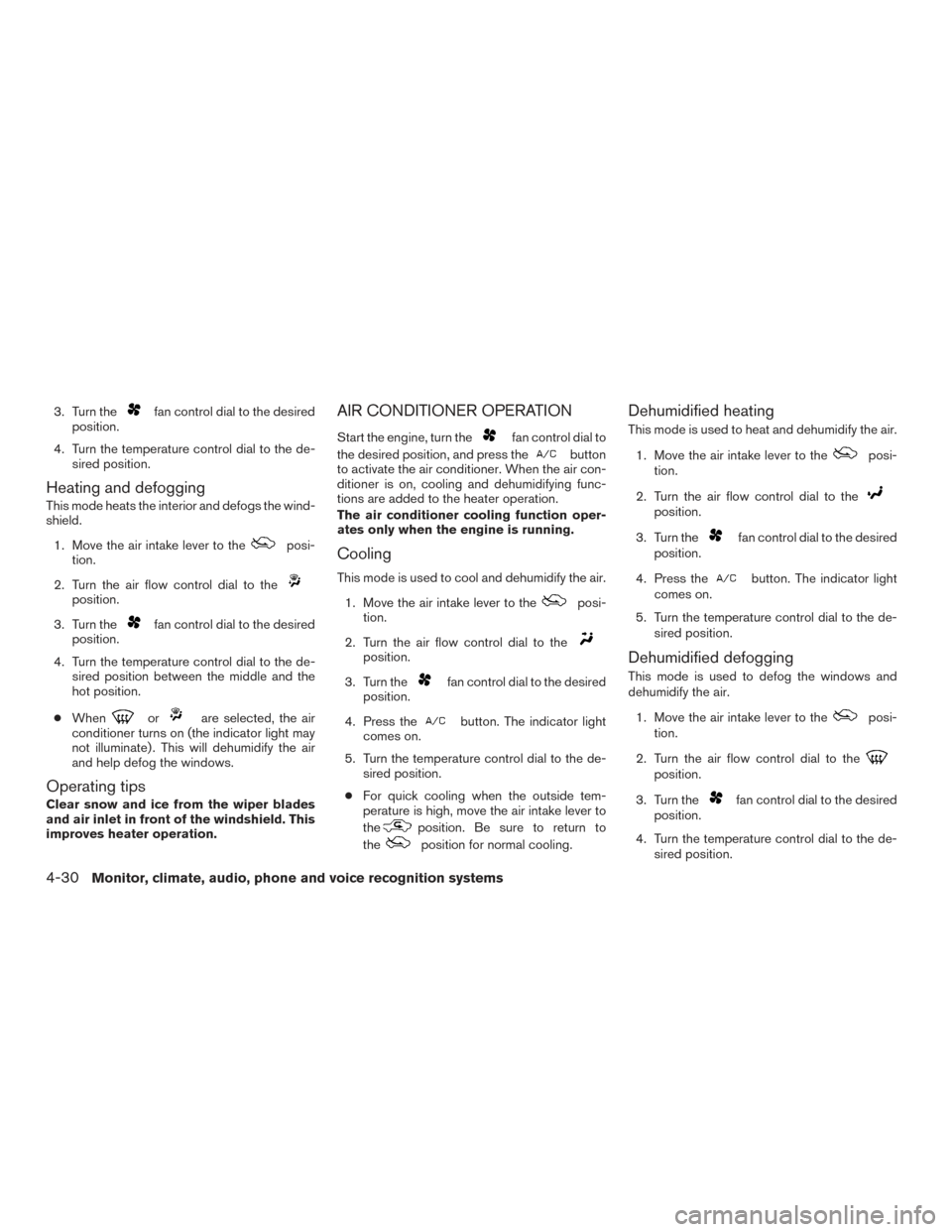
3. Turn thefan control dial to the desired
position.
4. Turn the temperature control dial to the de- sired position.
Heating and defogging
This mode heats the interior and defogs the wind-
shield.
1. Move the air intake lever to the
posi-
tion.
2. Turn the air flow control dial to the
position.
3. Turn the
fan control dial to the desired
position.
4. Turn the temperature control dial to the de- sired position between the middle and the
hot position.
● When
orare selected, the air
conditioner turns on (the indicator light may
not illuminate) . This will dehumidify the air
and help defog the windows.
Operating tips
Clear snow and ice from the wiper blades
and air inlet in front of the windshield. This
improves heater operation.
AIR CONDITIONER OPERATION
Start the engine, turn thefan control dial to
the desired position, and press the
button
to activate the air conditioner. When the air con-
ditioner is on, cooling and dehumidifying func-
tions are added to the heater operation.
The air conditioner cooling function oper-
ates only when the engine is running.
Cooling
This mode is used to cool and dehumidify the air.
1. Move the air intake lever to the
posi-
tion.
2. Turn the air flow control dial to the
position.
3. Turn the
fan control dial to the desired
position.
4. Press the
button. The indicator light
comes on.
5. Turn the temperature control dial to the de- sired position.
● For quick cooling when the outside tem-
perature is high, move the air intake lever to
the
position. Be sure to return to
the
position for normal cooling.
Dehumidified heating
This mode is used to heat and dehumidify the air.
1. Move the air intake lever to the
posi-
tion.
2. Turn the air flow control dial to the
position.
3. Turn the
fan control dial to the desired
position.
4. Press the
button. The indicator light
comes on.
5. Turn the temperature control dial to the de- sired position.
Dehumidified defogging
This mode is used to defog the windows and
dehumidify the air.
1. Move the air intake lever to the
posi-
tion.
2. Turn the air flow control dial to the
position.
3. Turn the
fan control dial to the desired
position.
4. Turn the temperature control dial to the de- sired position.
4-30Monitor, climate, audio, phone and voice recognition systems
Page 328 of 414
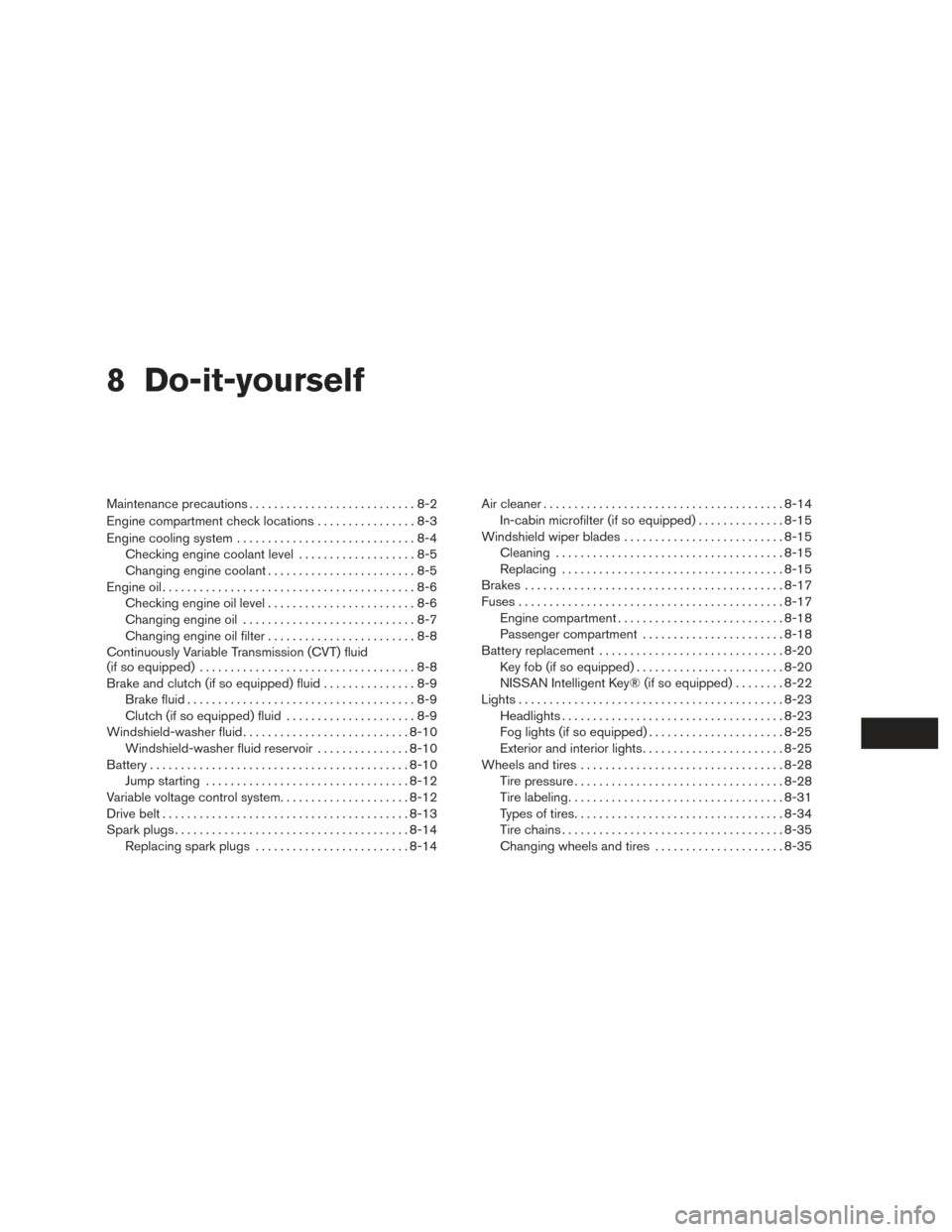
8 Do-it-yourself
Maintenance precautions...........................8-2
Engine compartment check locations ................8-3
Engine cooling system .............................8-4
Checking engine coolant level ...................8-5
Changing engine coolant ........................8-5
Engine oil .........................................8-6
Checking engine oil level ........................8-6
Changing engine oil ............................8-7
Changing engine oil filter ........................8-8
Continuously Variable Transmission (CVT) fluid
(if so equipped) ...................................8-8
Brake and clutch (if so equipped) fluid ...............8-9
Brake fluid .....................................8-9
Clutch (if so equipped) fluid .....................8-9
Windshield-washer fluid ........................... 8-10
Windshield-washer fluid reservoir ...............8-10
Battery .......................................... 8-10
Jump starting ................................. 8-12
Variable voltage control system .....................8-12
Drive belt ........................................ 8-13
Spark plugs ...................................... 8-14
Replacing spark plugs ......................... 8-14Air cleaner
....................................... 8-14
In-cabin microfilter (if so equipped) ..............8-15
Windshield wiper blades .......................... 8-15
Cleaning ..................................... 8-15
Replacing .................................... 8-15
Brakes .......................................... 8-17
Fuses ........................................... 8-17
Engine compartment ........................... 8-18
Passenger compartment .......................8-18
Battery replacement .............................. 8-20
Key fob (if so equipped) ........................ 8-20
NISSAN Intelligent Key® (if so equipped) ........8-22
Lights ........................................... 8-23
Headlights .................................... 8-23
Fog lights (if so equipped) ......................8-25
Exterior and interior lights .......................8-25
Wheels and tires ................................. 8-28
Tire pressure .................................. 8-28
Tire
labeling ................................... 8-31
Types of tires .................................. 8-34
Tire chains .................................... 8-35
Changing wheels and tires .....................8-35
Page 351 of 414
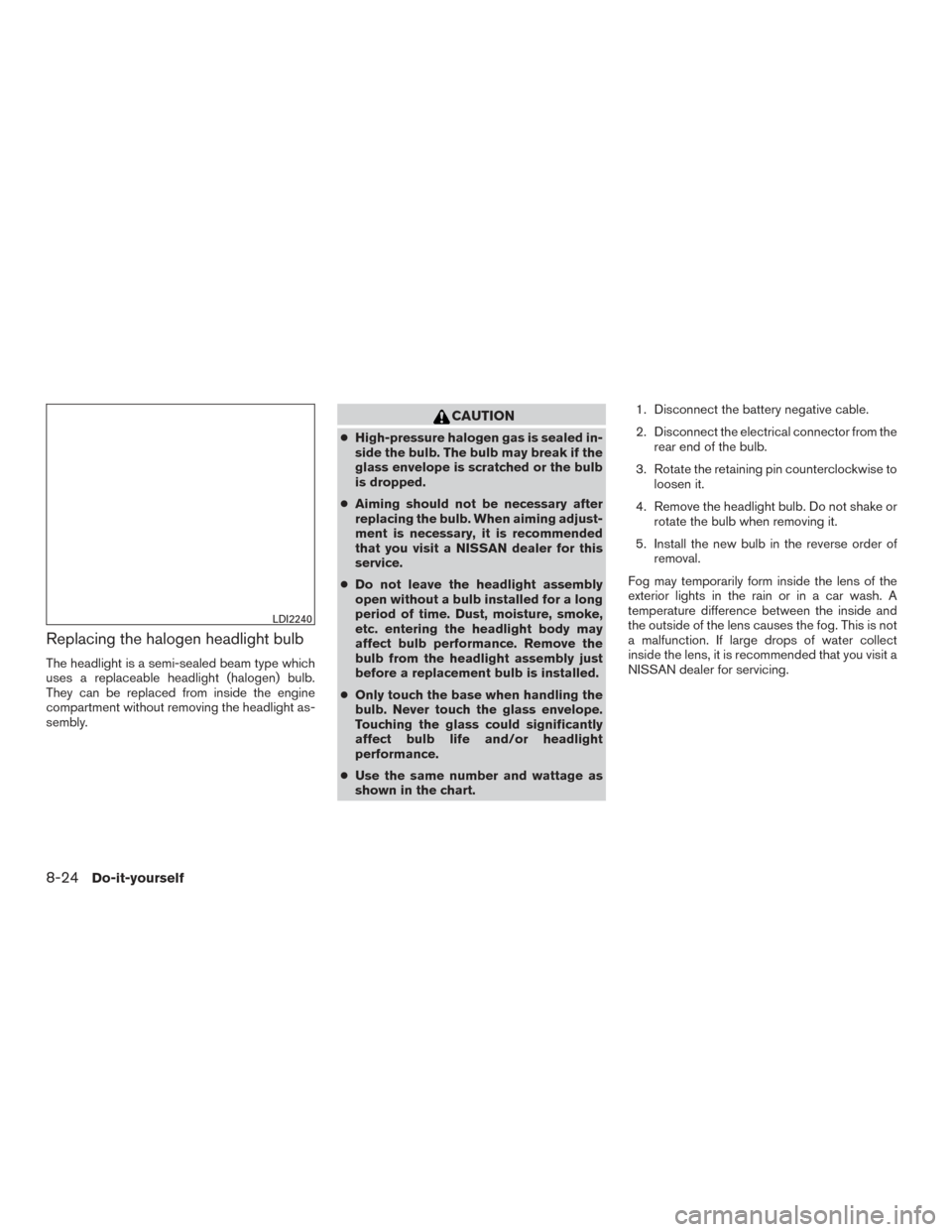
Replacing the halogen headlight bulb
The headlight is a semi-sealed beam type which
uses a replaceable headlight (halogen) bulb.
They can be replaced from inside the engine
compartment without removing the headlight as-
sembly.
CAUTION
●High-pressure halogen gas is sealed in-
side the bulb. The bulb may break if the
glass envelope is scratched or the bulb
is dropped.
● Aiming should not be necessary after
replacing the bulb. When aiming adjust-
ment is necessary, it is recommended
that you visit a NISSAN dealer for this
service.
● Do not leave the headlight assembly
open without a bulb installed for a long
period of time. Dust, moisture, smoke,
etc. entering the headlight body may
affect bulb performance. Remove the
bulb from the headlight assembly just
before a replacement bulb is installed.
● Only touch the base when handling the
bulb. Never touch the glass envelope.
Touching the glass could significantly
affect bulb life and/or headlight
performance.
● Use the same number and wattage as
shown in the chart. 1. Disconnect the battery negative cable.
2. Disconnect the electrical connector from the
rear end of the bulb.
3. Rotate the retaining pin counterclockwise to loosen it.
4. Remove the headlight bulb. Do not shake or rotate the bulb when removing it.
5. Install the new bulb in the reverse order of removal.
Fog may temporarily form inside the lens of the
exterior lights in the rain or in a car wash. A
temperature difference between the inside and
the outside of the lens causes the fog. This is not
a malfunction. If large drops of water collect
inside the lens, it is recommended that you visit a
NISSAN dealer for servicing.
LDI2240
8-24Do-it-yourself
Page 352 of 414
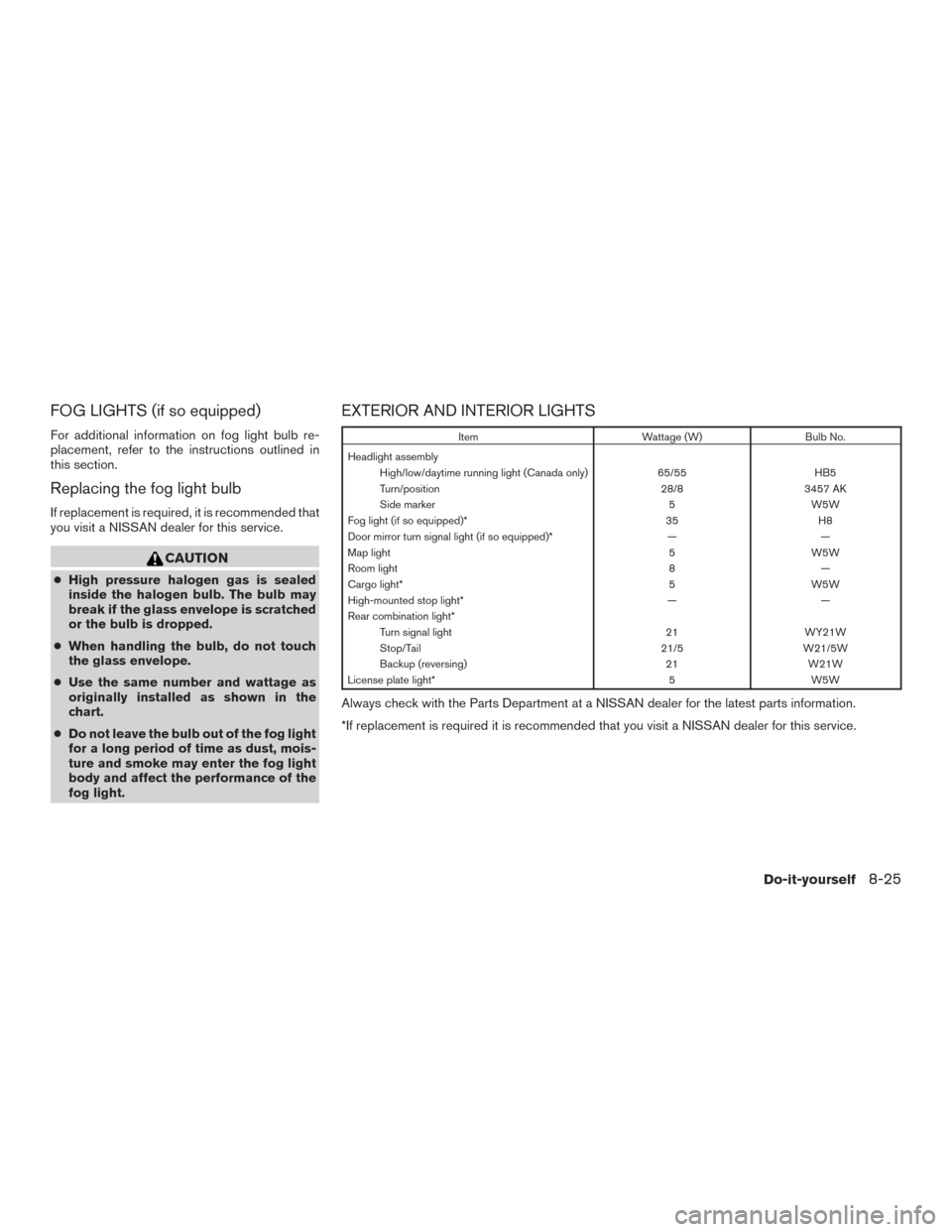
FOG LIGHTS (if so equipped)
For additional information on fog light bulb re-
placement, refer to the instructions outlined in
this section.
Replacing the fog light bulb
If replacement is required, it is recommended that
you visit a NISSAN dealer for this service.
CAUTION
●High pressure halogen gas is sealed
inside the halogen bulb. The bulb may
break if the glass envelope is scratched
or the bulb is dropped.
● When handling the bulb, do not touch
the glass envelope.
● Use the same number and wattage as
originally installed as shown in the
chart.
● Do not leave the bulb out of the fog light
for a long period of time as dust, mois-
ture and smoke may enter the fog light
body and affect the performance of the
fog light.
EXTERIOR AND INTERIOR LIGHTS
Item Wattage (W)Bulb No.
Headlight assembly High/low/daytime running light (Canada only) 65/55HB5
Turn/position 28/83457 AK
Side marker 5W5W
Fog light (if so equipped)* 35H8
Door mirror turn signal light (if so equipped)* ——
Map light 5W5W
Room light 8—
Cargo light* 5W5W
High-mounted stop light* ——
Rear combination light* Turn signal light 21WY21W
Stop/Tail 21/5W21/5W
Backup (reversing) 21W21W
License plate light* 5W5W
Always check with the Parts Department at a NISSAN dealer for the latest parts information.
*If replacement is required it is recommended that you visit a NISSAN dealer for this service.
Do-it-yourself8-25
Page 353 of 414
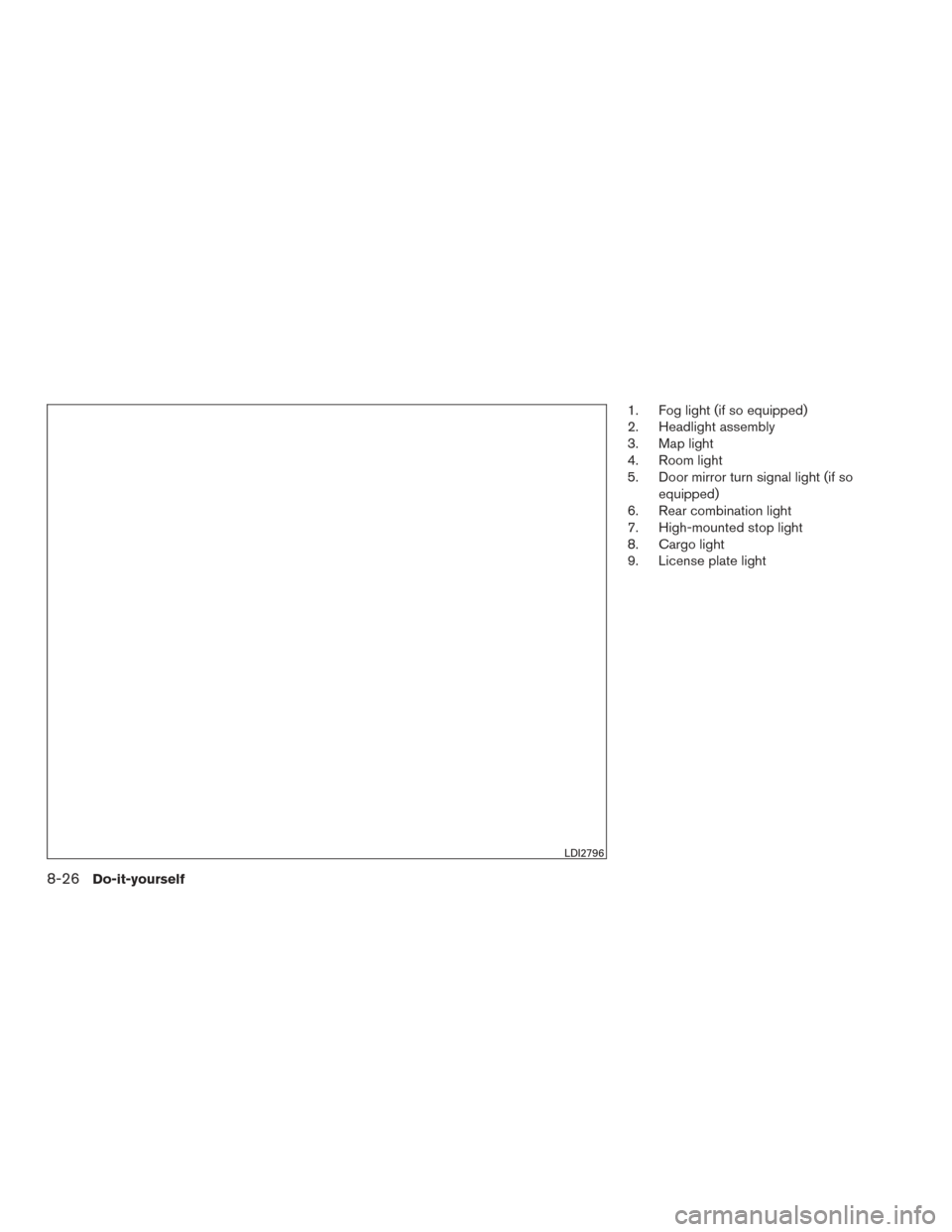
1. Fog light (if so equipped)
2. Headlight assembly
3. Map light
4. Room light
5. Door mirror turn signal light (if soequipped)
6. Rear combination light
7. High-mounted stop light
8. Cargo light
9. License plate light
LDI2796
8-26Do-it-yourself
Page 408 of 414
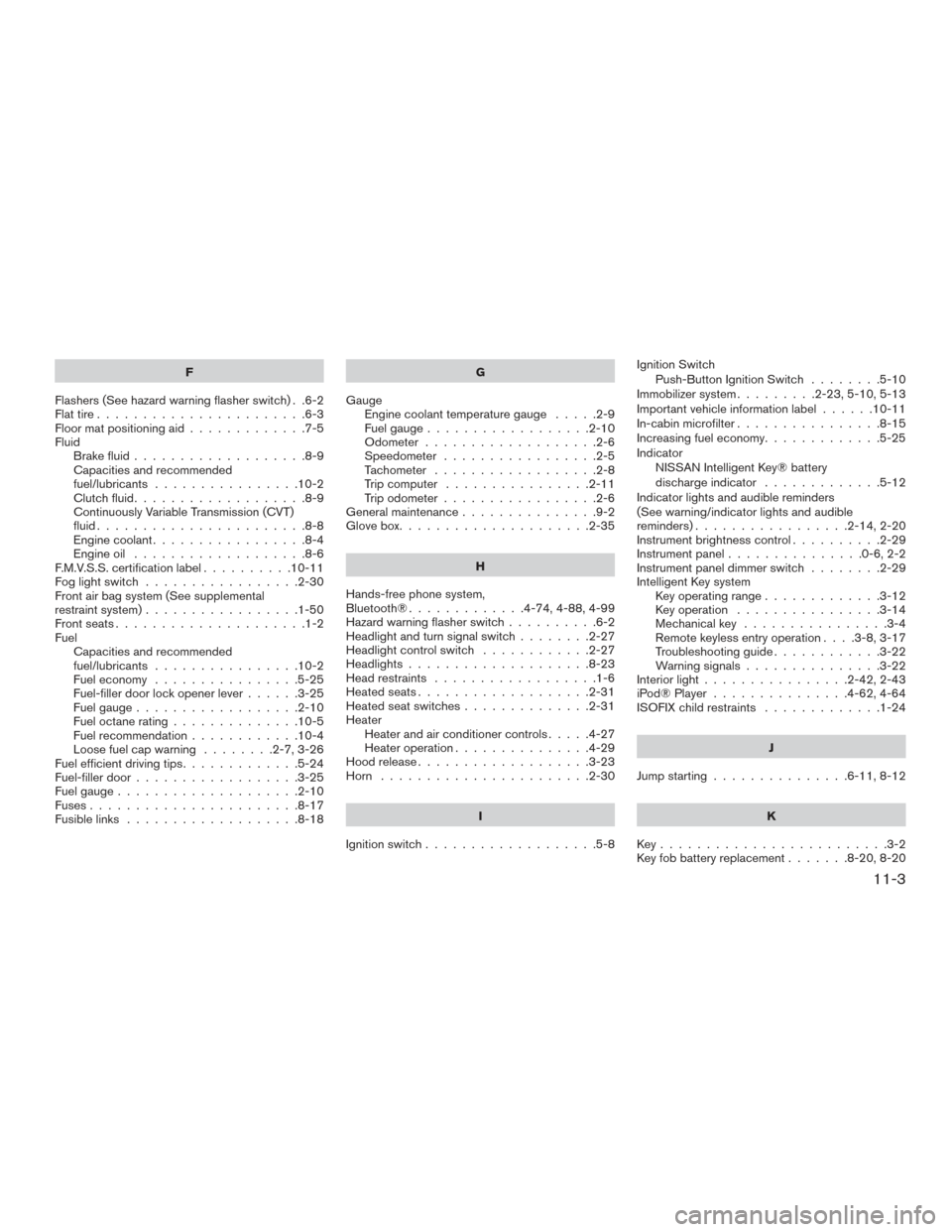
F
Flashers (See hazard warning flasher switch) . .6-2
Flat tire .......................6-3
Floor mat positioning aid .............7-5
Fluid Brake fluid ...................8-9
Capacities and recommended
fuel/lubricants ................10-2
Clutchfluid...................8-9
Continuously Variable Transmission (CVT)
fluid.......................8-8
Engine coolant .................8-4
Engine oil ...................8-6
F.M.V.S.S. certification label ..........10-11
Foglightswitch .................2-30
Front air bag system (See supplemental
restraint system) .................1-50
Frontseats.....................1-2
Fuel Capacities and recommended
fuel/lubricants ................10-2
Fuel economy ................5-25
Fuel-filler door lock opener lever ......3-25
Fuel gauge ..................2-10
Fuel octane rating ..............10-5
Fuel recommendation ............10-4
Loose fuel cap warning ........2-7,3-26
Fuel efficient driving tips .............5-24
Fuel-filler door ..................3-25
Fuel gauge ....................2-10
Fuses.......................8-17
Fusible links ...................8-18 G
Gauge Engine coolant temperature gauge .....2-9
Fuel gauge ..................2-10
Odometer ...................2-6
Speedometer .................2-5
Tachometer ..................2-8
Trip computer ................2-11
Trip odometer .................2-6
General maintenance ...............9-2
Glovebox.....................2-35
H
Hands-free phone system,
Bluetooth®.............4-74,4-88,4-99
Hazard warning flasher switch ..........6-2
Headlight and turn signal switch ........2-27
Headlight control switch ............2-27
Headlights ....................8-23
Head restraints ..................1-6
Heated seats ...................2-31
Heated seat switches ..............2-31
Heater Heater and air conditioner controls .....4-27
Heater operation ...............4-29
Hood release ...................3-23
Horn .......................2-30
I
Ignition switch ...................5-8 Ignition Switch
Push-Button Ignition Switch ........5-10
Immobilizer system .........2-23,5-10,5-13
Important vehicle information label ......10-11
In-cabin microfilter ................8-15
Increasing fuel economy .............5-25
Indicator NISSAN Intelligent Key® battery
discharge indicator .............
5
-12
Indicator lights and audible reminders
(See warning/indicator lights and audible
reminders).................2-14,2-20
Instrument brightness control ..........2-29
Instrumentpanel...............0-6,2-2
Instrument panel dimmer switch ........2-29
Intelligent Key system Key operating range .............3-12
Key operation ................3-14
Mechanical key ................3-4
Remote keyless entry operation ....3-8,3-17
Troubleshooting guide ............3-22
Warning signals ...............3-22
Interior light ................2-42,2-43
iPod®Player ............... 4-62, 4-64
ISOFIX child restraints .............1-24
J
Jump starting ...............6-11,8-12
K
Key.........................3-2
Key fob battery replacement .......8-20,8-20
11-3
Page 409 of 414
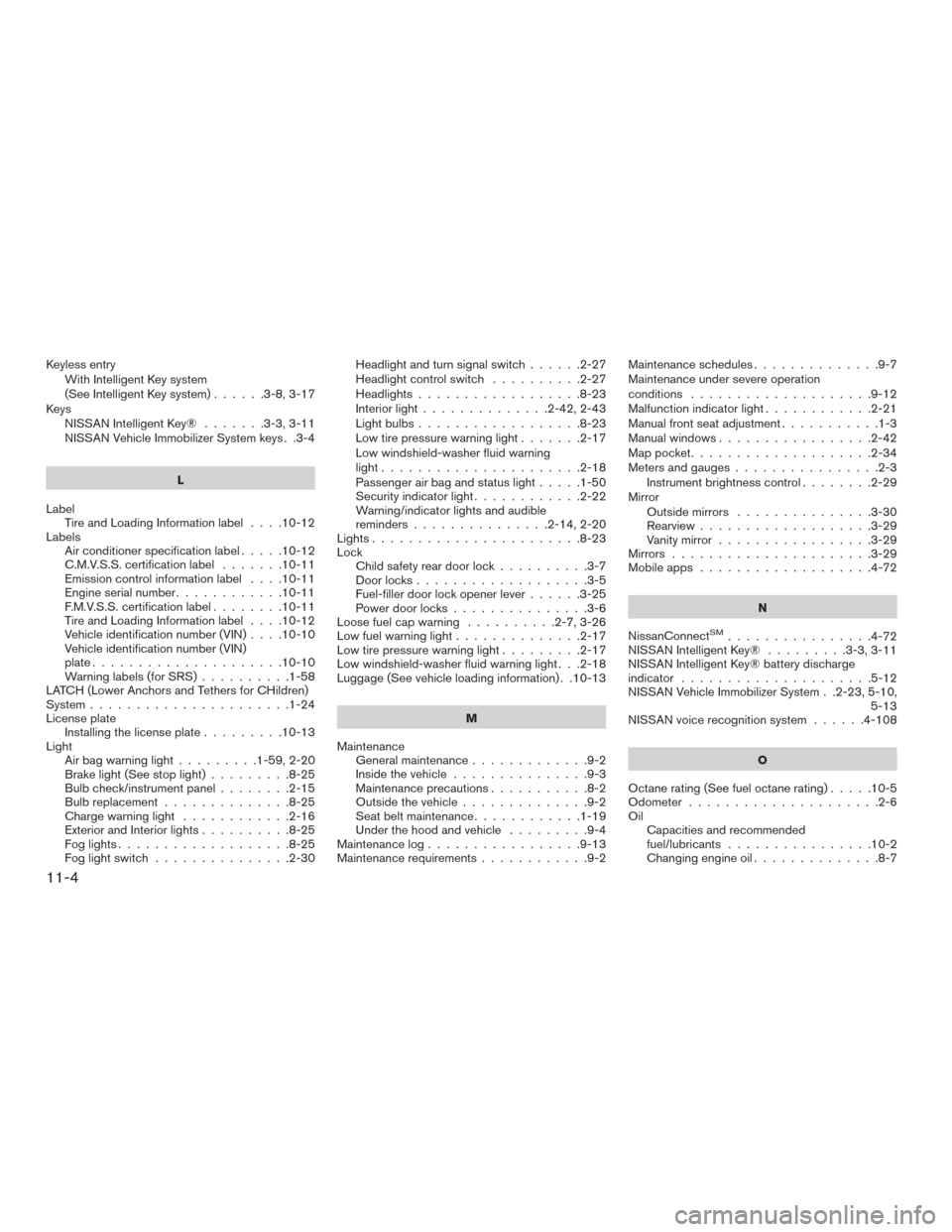
Keyless entryWith Intelligent Key system
(See Intelligent Key system) ......3-8,3-17
Keys NISSAN Intelligent Key® .......3-3,3-11
NISSAN Vehicle Immobilizer System keys . .3-4
L
Label Tire and Loading Information label ....10-12
Labels Air conditioner specification label .....10-12
C.M.V.S.S. certification label .......10-11
Emissioncontrolinformationlabel ....10-11
Engine serial number ............10-11
F.M.V.S.S. certification label ........10-11
Tire and Loading Information label ....10-12
Vehicle identification number (VIN) ....10-10
Vehicle identification number (VIN)
plate .....................10-10
Warning labels (for SRS) ..........1-58
LATCH (Lower Anchors and Tethers for CHildren)
System ......................1-24
License plate Installing the license plate .........10-13
Light Airbagwarninglight.........1-59,2-20
Brake light (See stop light) .........8-25
Bulb check/instrument panel ........2-15
Bulb replacement ..............8-25
Charge warning light ............2-16
ExteriorandInteriorlights..........8-25
Foglights...................8-25
Foglightswitch ...............2-30 Headlight and turn signal switch
......2-27
Headlight control switch ..........2-27
Headlights..................8-23
Interiorlight..............2-42,2-43
Lightbulbs..................8-23
Low tire pressure warning light .......2-17
Low windshield-washer fluid warning
light......................2-18
Passenger air bag and status light .....1-50
Security indicator light ............2-22
Warning/indicator lights and audible
reminders ...............2-14,2-20
Lights.......................8-23
Lock Child safety rear door lock ..........3-7
Door locks ...................3-5
Fuel-filler door lock opener lever ......3-25
Power door locks ...............3-6
Loose fuel cap warning ..........2-7,3-26
Lowfuelwarninglight..............2-17
Low tire pressure warning light .........2-17
Low windshield-washer fluid warning light . . .2-18
Luggage (See vehicle loading information) . .10-13
M
Maintenance Generalmaintenance.............9-2
Insidethevehicle...............9-3
Maintenance precautions ...........8-2
Outside the vehicle ..............9-2
Seatbeltmaintenance............1-19
Underthehoodandvehicle .........9-4
Maintenancelog.................9-13
Maintenancerequirements............9-2 Maintenance schedules
..............9-7
Maintenance under severe operation
conditions ....................9-12
Malfunction indicator light ............2-21
Manual front seat adjustment ...........1-3
Manual windows .................2-42
Mappocket....................2-34
Meters and gauges ................2-3
Instrument brightness control ........2-29
Mirror Outside mirrors ...............3-30
Rearview ...................3-29
Vanity mirror .................3-29
Mirrors ......................3-29
Mobileapps ...................4-72
N
NissanConnect
SM................4-72
NISSAN Intelligent Key® .........3-3,3-11
NISSAN Intelligent Key® battery discharge
indicator .....................5-12
NISSAN Vehicle Immobilizer System . .2-23, 5-10, 5-13
NISSAN voice recognition system ......4-108
O
Octane rating (See fuel octane rating) .....10-5
Odometer .....................2-6
Oil Capacities and recommended
fuel/lubricants ................10-2
Changingengineoil..............8-7
11-4